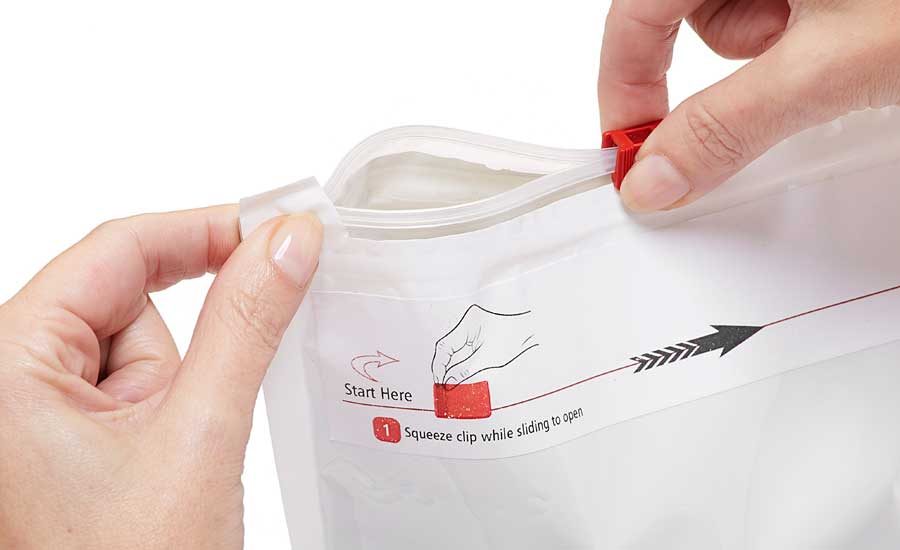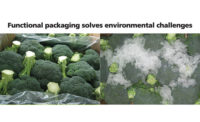CANNABIS PRODUCTS - MARCH 2019
Selecting the right child-resistant packaging for legal cannabis edibles
Cannabis edibles makers are searching for new closures and styles for child-resistant packaging.

Kush plans to launch a variety of new patented child-resistant packaging styles with a goal of hiding child-resistant features.
Courtesy of Kush Supply Co.

Zip-Pak introduced a child-resistant closure with a red clip that has to be squeezed for the interlocking pieces to open when you slide the clip.
Courtesy of Zip-Pak

Courtesy of Chill Chocolate



Packaging suppliers are rushing to provide new child-resistant bottles, tins, jars and bags for legal cannabis edibles to offer variety that producers find lacking.
Because child-resistant packaging requirements vary in states where cannabis is legal, many companies infusing food and drinks choose containers with the best protection—required or not—so they can sell the same packages everywhere. But they still want to offer attractive, affordable packaging to help meet their sales and cost targets.
A Safe Approach
Dixie Brands, Denver, worked with TricorBraun to engineer a proprietary bottle with a push-and-turn dosing cap for its flagship elixir products made since 2009. But it has had a hard time finding other unique or progressive child-resistant packaging that competitors haven’t seen and will help products stand out behind dispensary counters, says Dave Grigsby, national brand director. “There’s a tremendous opportunity for packaging suppliers to really capitalize on this exploding market.”
Building a national brand is difficult without federal regulations on labeling and protections to prevent children from accidentally consuming gummies, chocolates and beverages with cannabis. To avoid major packaging changes to fit state-by-state regulations, packaging companies often advise customers to upgrade to using all child-resistant containers.
“We’re pushing our clients, even if child-resistant isn’t necessary just yet, to keep the brand identity. Go child-resistant, and you’re going to be in a good place,” says Jason Vegotsky, president, Kush Supply Co., Garden Grove, CA. “You’re going to be overly compliant, and when the rules change, you’re going to be in a good spot. We ultimately feel that every state will be moving to child-resistant if they’re not already there.”
After states legalize cannabis, some start out requiring dispensaries to put products in child-resistant exit bags, but Kush has observed that as states mature through their regulation processes, they ultimately end up requiring child-resistant packaging for each product. As a result, child-resistant exit bags are not selling as heavily as they were two to three years ago.
The Next Generation
Kush plans to launch a variety of new patented child-resistant packaging styles, including a bottle for beverages, with a goal of hiding child-resistant features. “We’re continuing to spend money on innovating so that you can have child-resistant, but you can also look really cool doing it,” Vegotsky says. Done well, child-resistant features will not make a product look clunky or less attractive, he suggests. “Our job is to make a child-resistant package as closely similar—as possible—to just an everyday package.”
Parent company KushCo Holdings hired Silicon Valley industrial designer Steve Hwang as a president of its Koleto innovations division. After traveling to producers for several months to hear about their needs, Hwang is heading up the new child-resistant designs as the company tries to move all of its intellectual property in-house.
“Two to three years ago, we could have never pulled somebody like that,” says Vegotsky. “We’re starting to get innovative talent that is looking at this space.”
Zip-Pak, Carol Stream, IL, focuses on resealable zipper technology. The company notes that preliminary signs of interest from the cannabis industry in its new Safety-Lok child-resistant line for flexible plastic bags has come through its converting customers. Cannabis fits into the niche markets that converters serve, including companies with smaller production quantities that likely use premade bags, notes Barry Dauber, vice president and general manager.
The company introduced a child-resistant closure last year with a red clip that has to be squeezed for the interlocking pieces to open when you slide the clip. And it just announced a child-resistant press-to-close zipper, which has several locking tabs that must be pulled apart before the bag can be opened. The largest market for Safety-Lok has been for laundry and dish detergent pods, and the press-to-close version offers a more affordable option that is easier to integrate into varied bag designs and production, Dauber says.
The closures have been through successful child-resistant certification as part of a testing on whole packages using the zippers. “We know there’s a public health service to this product, and we are taking extra-special care in our factories and our testing methods to ensure that the products are working every time in every package the way they’re intended,” Dauber says.
At CRATIV Packaging, Denver, which sells child-resistant polypropylene clamshell boxes, Bill Ludlow, P.E., president, CEO and co-founder, first starting investigating cannabis packaging in Colorado in 2014. The only child-resistant packaging he saw then were pop-top tubes and round twist-and-turn medicine bottles. “What you saw was companies essentially stuffing chocolate chip cookies and various types of products into these bottles, and it just didn’t fit.”
Ludlow bought $500 worth of edibles so he could record their dimensions. “I measured every piece with calipers—XYZ dimensions—and counted the number of pieces and put that into a spreadsheet and that became our design input.” He and his business partner used the data to come up with a design that fit most of the items. Customers squeeze the sides of the CRATIV container and push in a tab on the front at the same time to open it. An airtight version is coming.
Mom and pop operations that have been making cannabis edibles out of small kitchens for years likely will not be able to afford child-resistant packaging to operate in a regulated environment, suggests Ludlow. And even some larger companies resist child-resistant packaging because of the extra cost. But many businesses will decide opting for 100 percent child-resistant packaging is the right thing to do and will recognize that any eventual federal legislation likely will require it.
“It’s the companies that step up and go the extra mile,” says Ludlow, “even if it’s not required, that are going to become more viable and eventually win in the long run.”
Looking for a reprint of this article?
From high-res PDFs to custom plaques, order your copy today!









